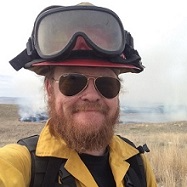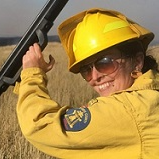Socio-Ecological Problems of Fire in Rangelands Wrought by Global Change
A special issue of Fire (ISSN 2571-6255).
Deadline for manuscript submissions: closed (31 October 2023) | Viewed by 4516
Special Issue Editors
2. Environmental & Conservation Sciences, North Dakota State University, Fargo, ND 58108, USA
Interests: sustainable agriculture; grazing; fire ecology; working landscapes; rangeland management
Special Issues, Collections and Topics in MDPI journals
Interests: physiological effects of fire on rangeland plants; rangeland community responses to fire, and traits-based approaches to ecosystem restoration; social and policy dimensions of prescribed fire use in rangelands
Special Issues, Collections and Topics in MDPI journals
Interests: fuels, and fire effects on vegetation in grasslands, including post-disturbance restoration; wildland-urban interfaces
Special Issues, Collections and Topics in MDPI journals
Special Issue Information
Dear Colleagues,
Rangelands are widely recognized as a varied and complex set of ecosystems that occur around the world. Many of these diverse ecosystems share three characteristics: They are working landscapes that support both biodiversity and rural livelihoods; wildland fire is an influential ecosystem process; myriad aspects of global change have the potential to disrupt or alter essential ecosystem functions. As in any ecosystem, the process of a disturbance like fire can be understood as a regime through the explicit description of factors such as the frequency, type, intensity, seasonality, and spatial pattern of vegetation combustion. Substantial changes to any aspect of a fire regime have the potential to alter the ecosystem’s capacity to function as required to deliver essential ecosystem services. In this Special Issue, we highlight efforts to understand the impacts of global change on rangeland fire regimes worldwide from both social and ecological perspectives. Authors are encouraged to identify “Wicked Problems” related to wildland fire at the interface of rangeland ecosystem integrity and human well-being, and address these problems by considering how aspects of fire regimes are altered by global change and how specific elements of the fire regime can be managed to mitigate these effects. “Global change” is considered broadly and can include but is not limited to the following: environmental changes such as average or extremes in temperature, precipitation, or nutrient inputs; invasive plant or animal species, woody plant encroachment, or changes in ecosystem management, that affect the amount, type, condition, and configuration of fuelbeds; land-use changes from agriculture, forestry, or energy development that contribute to landscape alterations such as fragmentation, settlement patterns, and broad vegetation types. A combination of both original social and ecological data is not required, but the socio-ecological context must be made clear. Reviews and case studies that meet these objectives are encouraged.
You may choose our Joint Special Issue in Land.
Dr. Devan Allen McGranahan
Dr. Carissa L. Wonkka
Dr. Sofía Laura Gonzalez
Guest Editors
Manuscript Submission Information
Manuscripts should be submitted online at www.mdpi.com by registering and logging in to this website. Once you are registered, click here to go to the submission form. Manuscripts can be submitted until the deadline. All submissions that pass pre-check are peer-reviewed. Accepted papers will be published continuously in the journal (as soon as accepted) and will be listed together on the special issue website. Research articles, review articles as well as short communications are invited. For planned papers, a title and short abstract (about 100 words) can be sent to the Editorial Office for announcement on this website.
Submitted manuscripts should not have been published previously, nor be under consideration for publication elsewhere (except conference proceedings papers). All manuscripts are thoroughly refereed through a single-blind peer-review process. A guide for authors and other relevant information for submission of manuscripts is available on the Instructions for Authors page. Fire is an international peer-reviewed open access monthly journal published by MDPI.
Please visit the Instructions for Authors page before submitting a manuscript. The Article Processing Charge (APC) for publication in this open access journal is 2400 CHF (Swiss Francs). Submitted papers should be well formatted and use good English. Authors may use MDPI's English editing service prior to publication or during author revisions.
Keywords
- Human dimensions of wildland fire
- Fire ecology, management, and policy
- Wildland fire regimes
- Rural livelihoods on rangelands
- Land-use change
- Global change impacts on ecological function and ecosystem service delivery







